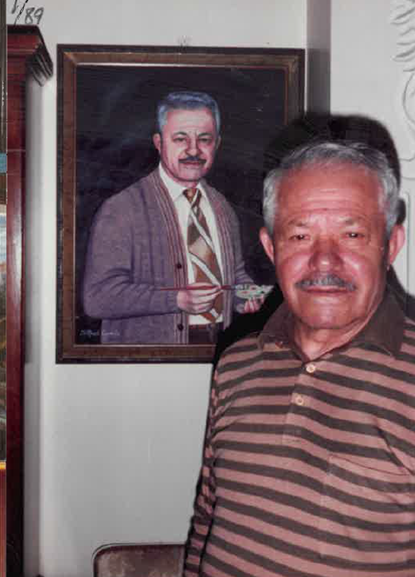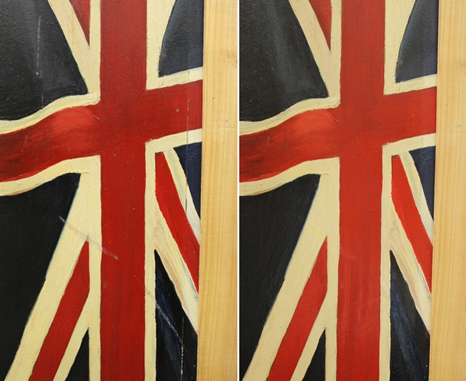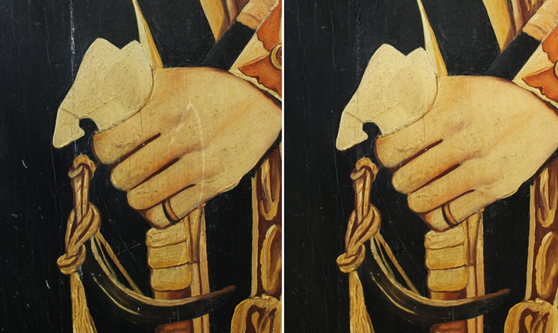Tracing the King’s portrait
In mid-February, the Australian War Memorial received an email from Joanne Tapiolas enquiring about a painting she had read about in a book about South Australia. The portrait of King George VI, painted from leftover paint found at 5 Central Ammunition Depot, was based on an image of the King taken from the cover of Australian Woman’s Weekly, 7 April 1945.
After researching the Memorial’s records, we were able to supply some additional details: the painting was donated in 1978 by the commanding officer of the 411 Supply Unit after being “rediscovered in the unit”; it was made of a 3-ply base, ammunition paint, and household paint brushes; and a signature in the lower left corner – “Godulo” – the name of an Italian Prisoner of War.
Alfred Goduto, His Majesty King George VI, 1946, ammunition paint on board, 150.6 x 99.8 cm, Australian War memorial.
Tapiolas replied with the details of Alfredo Goduto, complete with prisoner of war records, and some details of his paintings mentioned in several books. After confirming a few stylistic details, it appeared that we had a match. After entering the National Collection 42 years ago, the painting was correctly attributed.
The next step was to contact the Goduto family to ascertain further details about the painting. Tapiolas had already taken it upon herself to track down Goduto’s family, and the next day we received an email from Dominic, Goduto’s son. After a few emails back and forth, we learnt a little more about Alfredo and had permission to publish the work.
Goduto was captured at Bardia, Libya, on 3 January 1941. From there he was transported to India where he was interned alongside a Venetian painting teacher who taught him how to paint. His last transport as a prisoner of war was to Australia. By the end of the war he was in Camp Loveday in South Australia, where he completed the portrait of King George VI.
After the war, Goduto returned home to Italy. He moved to Sydney in the Canadian province of Nova Scotia in 1952 with his wife Bibiana and two young sons, Blaise and Dominic; their third child, Vincenza, was born soon after their arrival. In Canada, Goduto Anglicised his name to “Alfred” and worked in the construction business, continuing to paint in his spare time. Alfried Goduto died in 1990; his wife Bibiana passed away in 2017.

Photograph of Goduto with a self-portrait, 1989, courtesy of Dominic Goduto.
The painting of King George is documented in Sam Migliore and A. Evo DiPierro’s book Italian Lives: Cape Breton Memories, in which Goduto’s son Dominic recounts his father’s story:
In Australia, someone noticed his painting and wanted him to paint a full-sized portrait of King George V [sic] to hang in a community hall. It took Dad months to paint this life size portrait. The Australians treated him like a king at this point … they gave him everything he wanted because he was working very hard on this important project.
On completion the painting was shown to an artist in the town, who, while criticising the depiction of the King’s hands, was impressed, offering Goduto a job after the war, which he would ultimately decline. Goduto was very popular among Australian soldiers and Italian prisoners.
The portrait has recently been conserved by the Memorial. Some examples of the work are presented below.


Details showing conservation work on His Majesty King George VI, C175731, with watercolour overpainting of abrasion transfer marks, accretions and damage from a frame prior to its arrival at the Memorial.
Today the painting remains in storage, but with this new information coming to light, it is sure to attract interest.
We would like to thank Joanne Tapiolas for contacting the Memorial, and for sharing her research.
Tapiolas’ research focuses almost entirely on Italian prisoners of war who were interned in Australia during the Second World War. Her research can be found on her website: https://italianprisonersofwar.com/
We would also like to thank Dominic Goduto for his kind permission to publish these images and allowing me to explore this artwork and its history.
